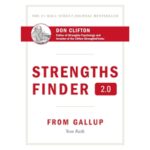LISTEN NOW
Outline: StrengthsFinder 2.0 by Tom Rath
Outline
Expand to Read ...
I. Introduction
- Purpose: The StrengthsFinder test, now called CliftonStrengths, focuses on identifying and enhancing personal strengths rather than addressing weaknesses.
- Core Argument: Success comes from leveraging innate talents, not trying to eliminate weaknesses.
- Structure of the Guide:
- The ideology and benefits of focusing on strengths.
- The 34 innate abilities identified by the test, categorized into:
- Action-oriented abilities
- Cognitive abilities
- Belief-based abilities
- People-oriented abilities
II. The Problem With Traditional Self-Improvement
- Traditional Approach: Focuses on correcting weaknesses.
- Example: Art classes focusing on improving poor sketching skills.
- Challenges:
- You Can’t Fully Overcome Weaknesses: Efforts to fix weaknesses yield limited results, especially compared to investing in innate strengths.
- Inefficiency: Time spent on weaknesses could be better used developing strengths.
III. The Solution: Build on Innate Strengths
- Key Principle: Focus on enhancing natural abilities to achieve greater success.
- Example: A poor sketch artist should focus on excelling in landscape painting if that’s their innate talent.
- The Strengths Test:
- Identifies 34 abilities.
- Highlights an individual’s top 5 or 10 strengths.
IV. The Four Categories of Innate Abilities
- Action-Oriented Abilities
- Key Traits: Drive progress and focus on achieving goals.
- Examples:
- Achiever: Motivated by goal-setting and accomplishment.
- Tip: Use benchmarks to track progress.
- Activator: Prefers immediate action and learning through experience.
- Tip: Embrace challenging situations to grow.
- Command: Leads with confidence and clarity.
- Tip: Learn to confront others constructively.
- Competition: Motivated by outperforming others.
- Tip: Compare yourself to stronger peers for improvement.
- Discipline: Values structure and routines.
- Tip: Stay flexible when plans don’t work.
- Learner: Enjoys continuous education and skill-building.
- Tip: Dedicate time daily to learning.
- Maximizer: Strives for perfection in tasks.
- Tip: Focus on long-term projects.
- Responsibility: Feels accountable for commitments.
- Tip: Avoid overcommitting.
- Restorative: Enjoys solving problems.
- Tip: Communicate your talent for troubleshooting.
- Achiever: Motivated by goal-setting and accomplishment.
- Cognitive Abilities
- Key Traits: Focus on thinking and problem-solving.
- Examples:
- Analytical: Seeks logical explanations and data validation.
- Tip: Learn to communicate analysis effectively.
- Arranger: Excels in planning and adapting to new information.
- Tip: Work in dynamic environments.
- Context: Uses historical knowledge to inform present decisions.
- Tip: Share past insights to improve current understanding.
- Deliberative: Makes careful, informed decisions.
- Tip: Trust your judgment even under pressure.
- Focus: Keeps teams aligned with goals.
- Tip: Create action plans to maintain progress.
- Futuristic: Envisions possibilities and long-term outcomes.
- Tip: Clearly communicate your vision to others.
- Ideation: Generates novel ideas and concepts.
- Tip: Schedule dedicated creative time.
- Input: Thrives on acquiring knowledge.
- Tip: Work with those who can apply your findings.
- Intellection: Excels in deep thought and problem-solving.
- Tip: Seek feedback alongside solitary reflection.
- Strategic: Plans for optimal outcomes.
- Tip: Pursue leadership roles.
- Adaptability: Thrives in uncertain, changing environments.
- Tip: Avoid rigid workplaces.
- Analytical: Seeks logical explanations and data validation.
- Belief-Based Abilities
- Key Traits: Rooted in personal values and ethics.
- Examples:
- Belief: Guided by strong principles and values.
- Tip: Seek meaningful work aligned with your values.
- Connectedness: Believes in the interconnection of actions and people.
- Tip: Help others see the impact of their work.
- Consistency/Includer: Advocates for equality and fairness.
- Tip: Find roles that elevate underrepresented groups.
- Peacemaker: Prioritizes harmony and consensus.
- Tip: Learn to address conflicts constructively.
- Optimist: Brings positivity to situations.
- Tip: Use optimism to motivate others, but avoid unrealistic expectations.
- Self-Assurance: Confident in personal decisions.
- Tip: Work in environments requiring independent judgment.
- Belief: Guided by strong principles and values.
- People-Oriented Abilities
- Key Traits: Centered on social interactions and relationships.
- Examples:
- Cheerleader: Encourages others’ growth and development.
- Tip: Focus on strengths over weaknesses.
- Storyteller: Communicates effectively through engaging narratives.
- Tip: Analyze effective stories to enhance your own communication.
- Commiserator: Understands and empathizes with others.
- Tip: Use empathy to mentor and support others.
- Intimate: Builds deep, meaningful relationships.
- Tip: Provide constructive honesty to close connections.
- Celebrity: Seeks recognition and attention.
- Tip: Balance external validation with intrinsic rewards.
- Befriender: Excels in making connections and winning people over.
- Tip: Build and nurture meaningful relationships for long-term success.
- Cheerleader: Encourages others’ growth and development.
V. Tips for Applying Strengths
- Optimize Strengths: Seek environments and roles that align with your innate abilities.
- Collaborate: Partner with others who complement your strengths.
- Avoid Overreach: Recognize when to delegate tasks outside your skill set.
VI. Conclusion
- Key Takeaway: Success stems from identifying and leveraging your strengths.
- Practical Application: Use the Strengths Test as a roadmap to focus your efforts, guide your career, and foster personal and professional growth.

 Buy on Amazon
Buy on Amazon